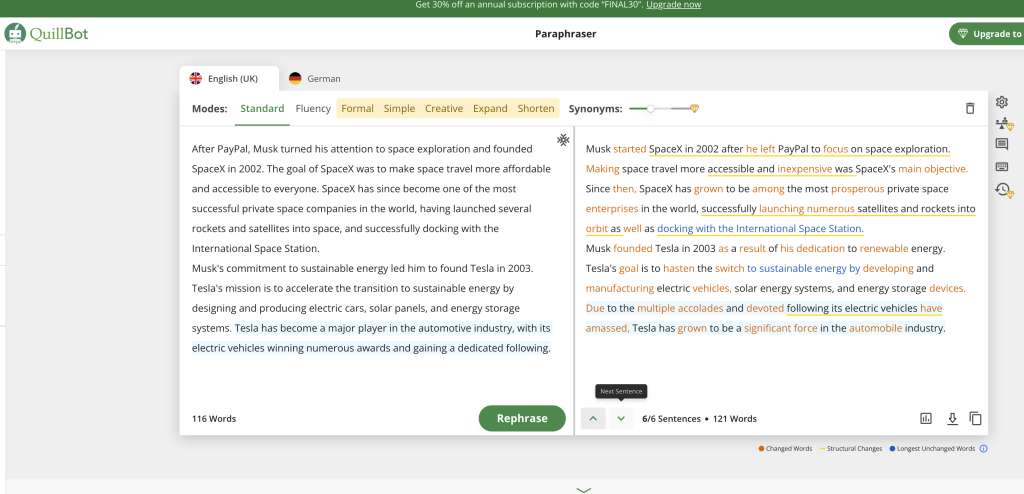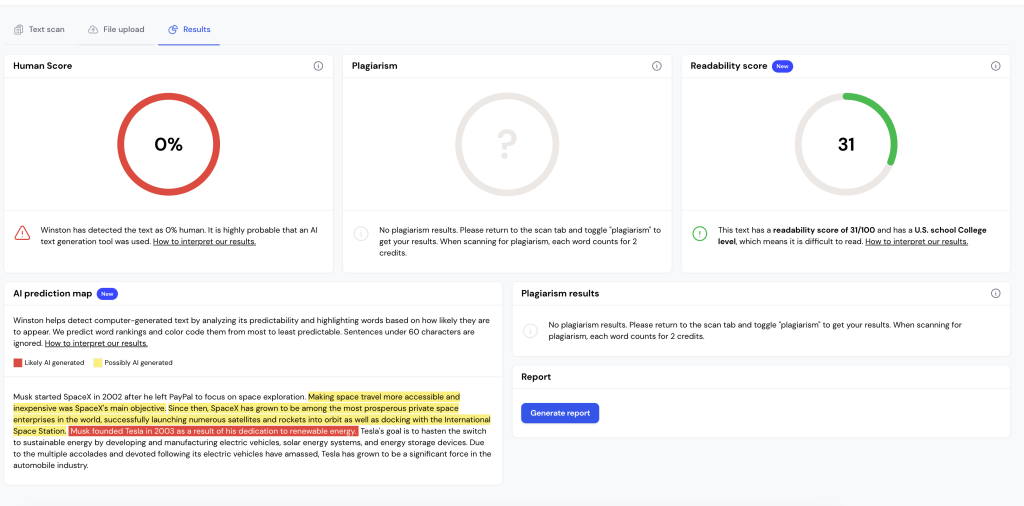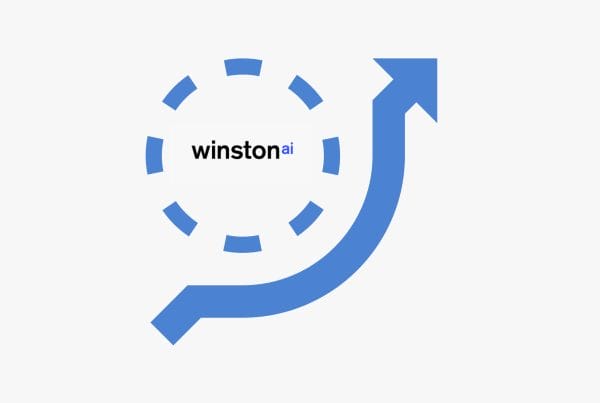One of the most widespread strategies to bypass AI content detectors is to run your ChatGPT content through a paraphrasing tool like Quillbot.
The short answer is that it will not bypass the Winston AI content detection solution, but it might work on free AI detectors.
We’ve conducted several tests on this matter and we’ll try and save you some time and trouble in the article below.
What are paraphrasing tools and how do they work exactly?
Paraphrasing tools like Quillbot are softwares that helps reword or rewrite text while retaining the core meaning. They aim to keep the structure and logic intact but change the vocabulary and sentence structure. The goal of a paraphrasing tool is to generate unique content that conveys the same ideas but avoids plagiarism. Some of the things a paraphrasing tool may do are:
- Replace words with synonyms: For example, replace “big” with “large”, “said” with “stated”, etc.
- Change sentence structure: For example, convert from active to passive voice, change parts of speech, reorder clauses, etc.
- Rephrase phrases and clauses: For example, rephrase “based on the aforementioned evidence” to “as per the evidence discussed above”.
- Shuffle word order: Change the sequence of words and phrases while ensuring coherence and logic.
- Insert transitional words: Add appropriate conjunctions, prepositions and adverbs to link sentences and make the rewritten content flow better.
- Remove repetitions: Replace repeated words and phrases with synonyms and pronouns to make the text concise.
- Maintain coherence: A good paraphrasing tool analyzes the context and relationships between sentences to generate a coherent rewritten version that preserves the original meaning.
The key benefits of using paraphrasing tools are to save time, avoid plagiarism, create more content from the same source and achieve better search engine rankings
Paraphrasing Tool Limitations in copywriting
The quality of the results from a paraphrasing tools will definitely vary. First, they often produce an output that is grammatically incorrect, confusing, or even nonsensical.
This can be especially problematic for academic writing, where accuracy and clarity are critical. Additionally, these tools often struggle with complex or technical language, leading to inaccuracies and errors in the paraphrased text.
Another issue is that using paraphrasing software can be seen as a form of plagiarism, as the resulting text may still closely resemble the original.
Can paraphrasing tools bypass AI content detectors?
In the below example, we’ve used a new tool called “Enhance” by GetConch to paraphrase an essay made by ChatGPT on Elon Musk. Their promise is to paraphrase the content and make it “undetectable by ai”.
The first observation is that rephrased content is nothing short of comical.

Although the rephrased content did bypass weaker free open source AI content detection tools, it did get flagged as likely AI generated by Winston AI.
We also tried submitting the same ChatGPT content on Quillbot. In this case, the rephrased content was much better. However, it failed to bypass any of the AI detectors.


Conclusion
In conclusion, while tools like Quillbot and other new so-called AI paraphrasers aimed to bypass AI detectors, keep in mind that advanced algorithms, like those used by Winston AI, can easily detect even the most sophisticated paraphrasing tools. Additionally, the paraphrased content produced by these tools often sounds ridiculous, which is another reason why they should be avoided. Ultimately, the best way to avoid plagiarism is to create original content that is free from any form of plagiarism or paraphrasing.
Frequently asked questions
A paraphrasing software automatically rewrites sentences or longer passages using different words and phrases that have the same meaning, to produce a new version that expresses the same ideas or information in a new way.
Paraphrasing tools replace words and phrases with synonyms. They have a built-in thesaurus that allows them to swap in synonymous words and phrases.
They change sentence structures. They can reorganize sentences by changing clauses around or combining and splitting sentences.
They remove and add transitional phrases. They may remove introductory phrases like “In addition, ” or “Moreover,” and add in different ones like “Furthermore,” or “Besides that.”
They remove duplications. They look for repeated words and ideas in the text and paraphrase them by using synonyms and restructuring sentences to avoid duplication.
The most used paraphrasing tool is definitely Quillbot. There are other options such as Outwrite, Rephrase.ai and even Grammarly offers paraphrasing as a feature.
Paraphrasing AI generated content will not bypass Winston AI, but it might work on a few other free AI detectors. Make sure your rephrased content still makes sense once processed if you use these tools.



